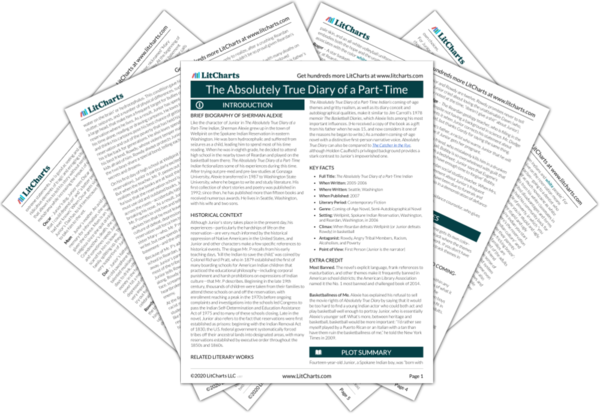Summary
Analysis
Fourteen-year-old Junior was “born with water on the brain”—that is, with too much cerebral spinal fluid, which damaged his brain when he was an infant. He notes that it might be more specific to say that his brain was “drowning in grease,” but that this statement sounds too goofy; to say he was born with water on the brain “seems more serious and poetic and accurate.”
The first thing Junior chooses to reveal about himself is his birth defect, showing that a sense of being “defective” is part of his identity—but also that he thinks of himself as someone who fights and beats the odds. He’s also very aware of the way he presents this information and constructs his identity through this written “diary.”
Themes
Junior’s hydrocephalus gave him a number of physical problems, such as ten extra teeth and lopsided vision, which the healthcare systems on his reservation had a limited ability to care for. For instance, because the Indian Health Service only funded major dental work once a year, he had to get all ten extra teeth pulled at once—by a white dentist who believed Indians only needed half as much Novocain as white people.
The barriers Junior faces as an Indian living on a reservation—the poverty of his family and their community, and the dentist’s racist beliefs—make his medical condition even harder to deal with, and make it even more difficult for Junior to be “normal.”
Themes
Junior also looked unusual, with a large head, hands, and feet on a very skinny body, and suffered from seizures, a stutter, and a lisp. Because of this, he has always been bullied by other kids and some adults. He gets beat up at least once a month, and so he prefers to spend his time alone inside, reading books and drawing cartoons.
Junior’s frank and humorous description of his physical problems makes his character seem likable and trustworthy, rather than simply a victim—even as it also makes clear that the odds are stacked against him. Meanwhile, his creativity grows out of his hardships.
Themes
Junior draws cartoons, especially cartoons of his friends and family, because he finds words too limited and unpredictable. In contrast, everyone in the world can understand a picture.
Junior’s cartoons are closely connected to his human relationships. He uses them to show how he feels about people, and also to bring people together. Drawing, he implies, can transcend things like class and race.
Themes
Get the entire Diary of a Part-Time Indian LitChart as a printable PDF.

Drawing also makes Junior feel important, as if he could grow up to be somebody famous: his artistic talent might be the one real chance he has to escape the reservation. He states, “I think the world is a series of broken dams and floods, and my cartoons are tiny little lifeboats.”
Junior hopes that drawing could make it possible for him to transcend his own class and race as well. The metaphor of lifeboats dramatizes this point, and links to the idea of “saving yourself” that Mr. P will bring up later on. After his long description of his handicaps, it is significant that Junior takes such pride in his cartoons. It shows his resilience.
Themes












